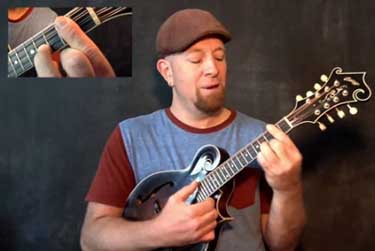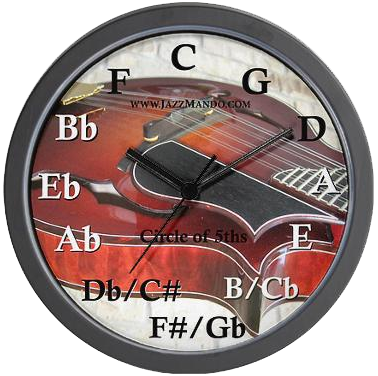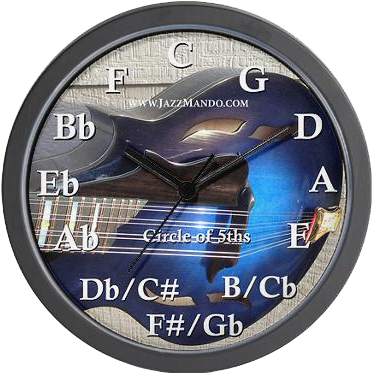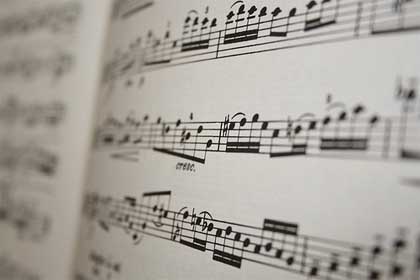« October 2014 |
Main
| December 2014 »
 November 27, 2014 | Zak Borden; Circle of 5ths Part 1
November 27, 2014 | Zak Borden; Circle of 5ths Part 1

We've mentioned the music and lessons of Brazillionaires mandolinist and clinician, Zak Borden in the past. His YouTube video series is effective at explaining some of the important theory and mandolin pedagogy that aren't always easily extracted out of a book. His latest is one of our favorite concepts, the Circle of 5ths.
Our instrument is already tuned in 5ths, and Zak exploits this as a jumping off point for getting into the larger elements of flats and sharps, enharmonic keys, and even relative minors. Even if you already have a grip on these, it's always great to see an effective teacher explain them.
Enjoy!
Video Link: Circle of 5ths Part 1
YouTube channel: Zak Borden
Purchase one (or both!) for your home or office from our CafePress JM Logo Store and help support the site while you're at it. Only $18.99!
If it's a gift for someone else, better order it today.
Click image(s) to purchase:

Circle of 5ths Wall Clock Cherry-Colaburst $18.99

Circle of 5ths Wall Clock Blueburst $18.99
Posted by Ted at 6:56 AM
 November 20, 2014 | What to do with my mandolins when I'm gone
November 20, 2014 | What to do with my mandolins when I'm gone

Cypress Creek Bluegrass Band, "You Can't Take It with You," Roy Jenkins
You Can't Take It with You
Ted Eschliman
It's important to include in any estate planning some kind of action or clause specifically on how to deal with musical instruments. A spouse or child distanced from or completely disengaged in your mandolin passion may have no idea of the worth of them, or even more uncomfortably, how little the value might be. It's a good idea to get an expert and trusted third party in place to handle evaluation in your departure, and just as importantly, distribution or sale of them. One of my most uncomfortable positions was having to tell a widow her husband's prized pro-model trumpet from the 50's just wasn't worth that much today. You'd be surprised at how often this happens, and how little spouses really know what these instruments might sell for.
In writing our own will, my wife and I included a clause that appointed a long-time trusted friend to deal with the sale of my mandolins. I didn't want either my wife or daughter to have to deal with this personally, or have to go looking for someone to handle it. We documented his name and outlined a 20% commission due on the sale of any of the instruments, with the remaining profits going to the estate. We thought it important to pay him for his time, energy, and expertise.
This would take the burden off the family, as well as assure maximum resale value. It's in a legal document, so there should be no question how this should be handled. You can't really transfer value on something that is as fluid as the selling market, but you can at least put a procedure in place that reduces the anguish of those who might grieve your absence.
Have one you want to pass on to a specific person, too? Absolutely, write that in. I have a violinist daughter that may want to play the mandolin someday, let alone treasure something to remember me by. Never hurts to include these instructions, too!
Shouldn't have to say it, but you can't be clear on your wishes when you're gone...
Posted by Ted at 3:01 PM
 November 13, 2014 | 5 Steps to Mastering Sight-Reading
November 13, 2014 | 5 Steps to Mastering Sight-Reading
If you're a simple folk musician, sight-reading is not a priority item in your took bag. You may function completely in an aural world, but if you've ever wanted to participate in an orchestra , or sit in with a reading band, you want good sight-reading chops.
A recent article in JazzAdvice.com gives some critical tips in developing this important skill, five steps in making print music work positively for you. We think it's important to be able to learn music through both eye and ear, so take some time to dig deeper into what it takes.

Mental check-list every time you see a piece of music:
- Get into the mindset of total concentration and tune out distractions
- Before you begin, memorize the key signature and scan the page for trouble spots
- Look at the music in larger chunks of time (see the page like it's in cut-time)
- Recognize common rhythms and watch out for tricky rhythms
- Visually identify scale fragments and arpeggios
- Remember to keep counting through rests
- Continually keep your eyes scanning ahead so you're always ready for the next measure
- Don't be phased by your mistakes, keep the time going and get back on track
Read article: 5 Steps to Mastering Sight-Reading
Concentration (I'm going to get every note right)
Read bigger chunks of music (Multiple measures or phrases)
Recognize rhythms and patterns (Uncover scales, arpeggios, trick rhythms, unusual rests)
Looking ahead (read what's coming up in addition to now)
Continue through your mistakes (don't dwell, move on)
Posted by Ted at 2:17 PM
 November 6, 2014 | How playing an instrument benefits your brain.
November 6, 2014 | How playing an instrument benefits your brain.
We love the YouTube videos and documentation supporting the connection between intellectual capacity and the brain. The latest one we've uncovered uses some very specific science to demonstrate how the act of playing a musical instrument is in essence a brain workout.

"When you listen to music, multiple areas of your brain become engaged and active. But when you actually play an instrument, that activity becomes more like a full-body brain workout. What's going on? Anita Collins explains the fireworks that go off in musicians' brains when they play, and examines some of the long-term positive effects of this mental workout."
Video Link:How playing an instrument benefits your brain
Further:
Charles Limb: Building the musical muscle/
The Jazz Brain; Improv
Numbers.
Fingers, Ears, Brain
Making sense. More than five senses?
Posted by Ted at 2:45 PM

Disclaimer: In the 'Information Age' of the 21st Century,
any fool with a computer, a modem, and an idea can
become a self-professed 'expert." This site does not
come equipped with 'discernment.'
|



